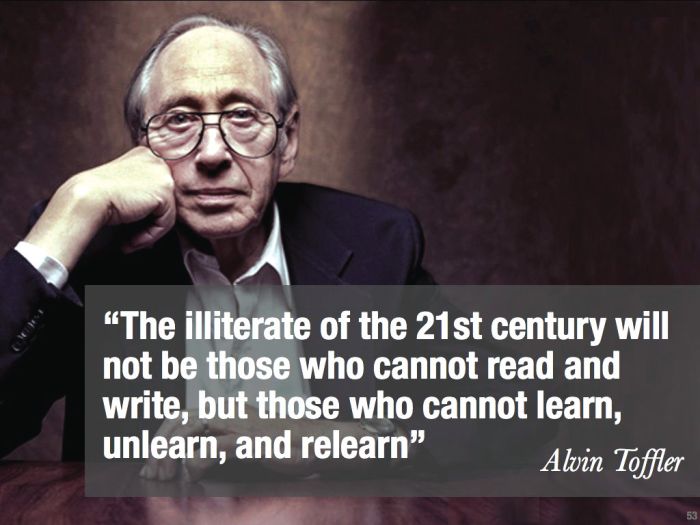--By Vaijayanti Khare
Many a young executive and senior manager lives in the ill-formed bubble that learning stops when a ‘job’ begins; that to learn is to be back in college and that to be working and learning is mutually exclusive. This fallacy is further fed by the inadequacy of the management and the organisation to give ‘learning’ the rightful place in the business.
A Learning Organisation is not a ‘thing of the 90s’. In fact, it is very much a part of the today, too. A Learning Organisation is one where people continually expand their capacity to create the results they truly desire, where new and expansive patterns of thinking are nurtured, where collective aspiration is set free, and where people are continually learning to see the whole together. The basic rationale for such organisations is that only those that are flexible, adaptive and productive will excel. For this to happen, it is argued, organisations need to ‘discover how to tap people’s commitment and capacity to learn at all levels’.
In our own business scenario here in Nepal, one clearly sees that a generation has moved up in all the business activities. The legacy of the grandfather is now the playing field of the grandchild –the third or even fourth generation in almost all our industry houses. New ones, that is, first generation business ventures are in by the hundreds! The time to re-organise, re-structure & re-calibrate our ways of an Organisation is Now. And the Learning Organisation begins at the top and then cascades down.
Each company and business unit must become a learning organisation. While all people have the capacity to learn, the structures in which they have to function are often not conducive to reflection and engagement. Furthermore, people may lack the tools and guiding ideas to make sense of the situations they face. Organisations that are continually expanding their capacity to create their future require a fundamental shift of mind among their members. Organisational research and experience over the past two decades has revealed three broad factors that are essential for organisational learning and adaptability:
1. A supportive learning environment
2. Concrete learning processes and practices
3. Leadership behavior that provides reinforcement
These are the building blocks of a real, effective Learning Organisation.
Organisational learning is strongly influenced by the behaviour of leaders. When leaders actively question and listen to employees—and thereby prompt dialogue and debate—people feel encouraged to learn. If leaders signal the importance of spending time on problem identification, knowledge transfer, and reflective post-audits, these activities are likely to flourish. When people in power demonstrate through their own behaviour a willingness to entertain alternative points of view, employees feel emboldened to offer new ideas and options.
By modeling desired behaviours—open-minded questioning, thoughtful listening and acceptance of opposing points of view—leaders are indeed likely to foster greater learning. However, learning-oriented leadership behaviours alone are not enough. The process dimensions of learning appear to require more explicit, targeted interventions. It is easier to find higher scores in learning leadership than in concrete learning processes or supportive learning environment. Clearly suggests that installing formal learning processes and cultivating a supportive learning climate requires steps beyond simply modifying leadership behaviour.
Organisations are not monolithic. Most, if not all, business houses in Nepal are conglomerates. Even each functional department within a business unit is ‘diverse’. We must be sensitive to differences among departmental processes and behaviours while making a learning organisation. Groups may vary in their focus or learning maturity and local cultures of learning impact differently across units.

In most settings, a one-size-fits-all strategy for building a learning organisation is unlikely to be successful. Simply because an organisation that scores itself highly in a certain area of behavior or processes does not make that area a source of competitive advantage. ‘Openness to new ideas’ and ‘training and development’ almost always scores higher than other attributes, probably because of its obvious link to organisational improvement and personal development; and yet, surprisingly, most of the organisations have very little to show in these areas as their areas of strength.
All too often, a company’s efforts to improve learning are concentrated in a single area—audits and reviews. However, each building block of a learning organisation (environment, processes, and leadership behaviours) is itself multidimensional and responds to different forces. You can enhance learning in an organisation in various ways, depending on the block you emphasise—for example, when it comes to improving the learning environment, one company might want to focus on setting up a learning centre and another on continuous effort at behaviour change across the workforce.
In a relatively stable external environment where changes can be seen within a time-frame that allows the organisation to change direction, the micro-learning organisation will benefit from a culture and structure, and policies and practices, which encourage and sustain the learning of all employees. The organisation learns to be efficient within the framework it has created or indeed accepted for itself. It may, for example, believe that its market domination is unbeatable and that there will be indefinite demand for its products or services. A micro-learning organisation does not seriously examine the kind of organisation it might or should be in an increasingly challenging business scenario.
The macro-learning organisation differs from the micro-learning organisation. It constantly examines its external environment, to plan well a change of direction. The macro-learning organisation builds in processes for thinking about its future and evaluating options, and seeks not just to react to future developments, but to influence them.
Often organisations are effective macro-learners but are weak at the micro-level. And some are often good at the micro-level but their life-span is threatened by weakness at the macro-level. A well thought out blend of organisational learning competence at the macro and the micro levels is the winning combination.
Why spend valuable time, money and resources on creating this ‘learning’ environment? Especially, as the employees ‘may leave’ and take away this learning to the competition? I have encountered this Big Question at almost every turn. And I am happy to explain, cajole and get such processes started. The benefits of making your Organisation a Learning one, are deep and sustained. In addition, it creates a whole industry or business environment that is far healthier in values, competency and excellence. A true organisational learning culture enables employees to challenge the status quo, think critically, and ensures that they do not become stuck in “this is the way it has always been done here” thinking, and instead, create the capacity and adaptability needed for change.
Still not convinced? A list of specific benefits could begin like this: Efficiency gains; Increased productivity, Increased profit; Decreased employee turnover - as employee satisfaction levels rise and loyalty and commitment is increased; Raising the bar by creating a continuous improvement mindset, shared ownership for projects and shared accountability for results; Developing leaders at all levels, which helps with succession planning; Creating a culture of inquiry, adaptive capacity, and knowledge sharing (vs. knowledge hoarding); Enhanced ability for individuals and teams to embrace and adapt to change.
A learning organisation breaks-down traditional silos, and enables all areas to work together towards a common vision.
Organisational learning is an ongoing, dynamic process, and should become part of the organisation’s DNA. A learning culture supports a community of learners, as a total organisation, where everyone teaches, everyone learns, everyone shares knowledge. Individual and collective learning is encouraged and rewarded. And those companies that embrace these values will be able to gain and sustain competitive advantage over competitors who do not.
Vaijayanti Khare is known for her dynamic engagements in the corporate, academic, social and development fields in Kathmandu over the past decade. Her writings are a reflection of her hands-on work, insights, studies, success and challenges.






















